This is the part I still don't quite understand. I asked this in the other thread, but how does him drowning at the end not erase all versions of Booker? If drowning Booker removes the paradox, how can he exist in the after-credits scene? I know the scene is there for a reason, I just don't understand how he can be alive again.
Well, one explanation is that there are other bookers in the multiverse who do not even go to the baptism, but that seems rather irrelevant to the nature of the game to be included such a way in the post-credit scene.
The nature of the paradox argument is that by ever having the choice to accept the baptism, Booker eventually is killed by Liz before the choice can actually be made in order to prevent Comstock from ever happening, which leads to old Liz destroying the world in fire Noah's ark style.
But as soon as Booker dies before the choice is ever made (the when is important), Liz as we know her, with her Tear abilities, ceases to exist. This happens because Liz only exists due to Comstock taking her, which was what led to her ability to create tears and eventually kill Booker before the choice is made.
But if she ceases to exist before Booker actually makes a choice, which is necessary for her to exist to drown him, how could she have ever killed Booker in the first place before the choice was made?
Thus, Booker ever accepting the baptism and creating Comstock will inevitably lead to the whole chain series of events of Infinite, which in the end, creates a paradoxical event that immediately 'rights' itself by removing the possibility from the universe.
Now, if Booker NEVER accepts the baptism, it's impossible for him to become Comstock. And since any Booker ever accepting the baptism will (as we understand it) always lead to the Comstock/Liz paradox, which erases itself, Booker refusing the baptism becomes the only remaining variable which is possible for the universe to accept and for time to continue. In essence, refusing becomes a constant of the universe, instead of a variable, hence the post-credits scene's existence.



